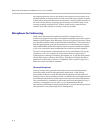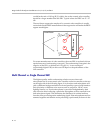
Designing Audio Conferencing Systems
B - 11
However, if ceiling microphones are swaying due to the air flow from nearby
HVAC ducts, noise cancellation may not be able to completely remove that
noise.
Acoustic Echo Cancellation
In audio conferencing applications, acoustic echoes occur because an open-air
acoustic path exists between the local loudspeaker and the local microphone.
As shown in the following figure, speech originating in either the local or
remote room is transmitted over a communications network to the other room
where it is amplified and reproduced by the local loudspeaker. The output of
the loudspeaker (or multiple loudspeakers) will fill the local room and, from
many paths of reflections, reach the microphones in the local room. In the
absence of an acoustic echo canceller, this acoustically-echoed version of the
remote talker's audio is transmitted back over the network to the originating
room and is reproduced by the loudspeaker where it is perceived as an
acoustic echo.
Acoustic echoes degrade the quality of speech communications because
echoes of one's speech are subjectively annoying to the person speaking. In
fact, if the elapsed time between when a word is spoken and when its echo is
heard is more than 300 msec, the echo will actually cause most talkers to
stutter. In addition, echoes can overload communication circuits, resulting in
a feedback condition called howling. If, by the combination of loudspeaker
volume and microphone sensitivity and positioning, the echoes are louder
than the originating speech, the teleconferencing equipment, or the network
itself, can overload.
An acoustic echo canceller in the local room will remove the echo of the remote
talkers' voice so it will not be sent back to the remote talkers. Just as an acoustic
echo canceller is used in the local room to prevent echoes to be sent to the
remote participants, the remote site would have a similar audio conferencing
solution to prevent the local talker's audio from echoing back from the remote
room as shown in the following figure.
The sophisticated part of an acoustic echo canceller consist of an adaptive filter
that is nearly continuously adapting to adjust to changes in the echoes in the
room caused by changes in the local room such as participants moving
A
EC
Local Room
AEC
Remote Room
Local Room
Remote Room
Remote Talker
A
mp
A
mp


















